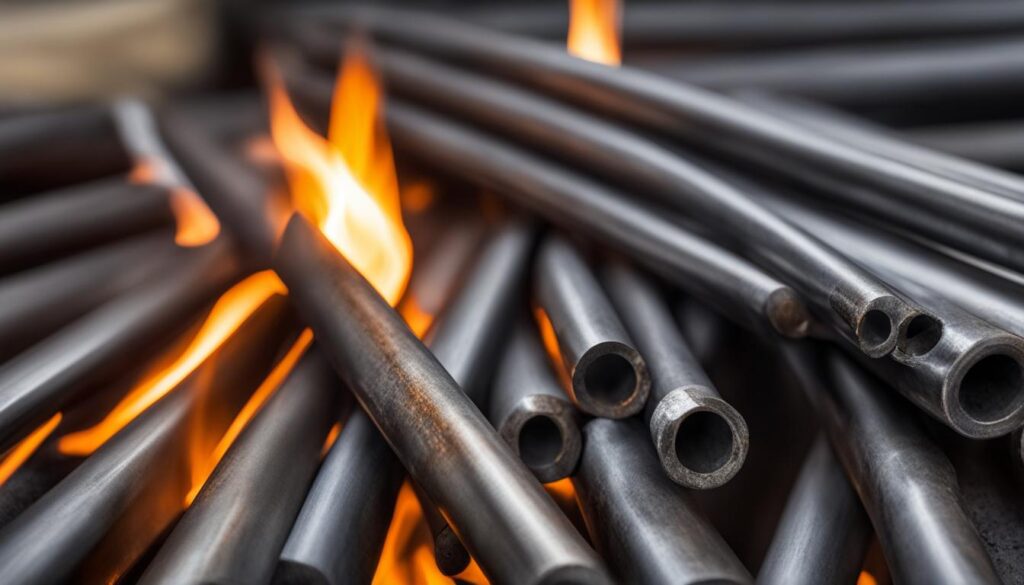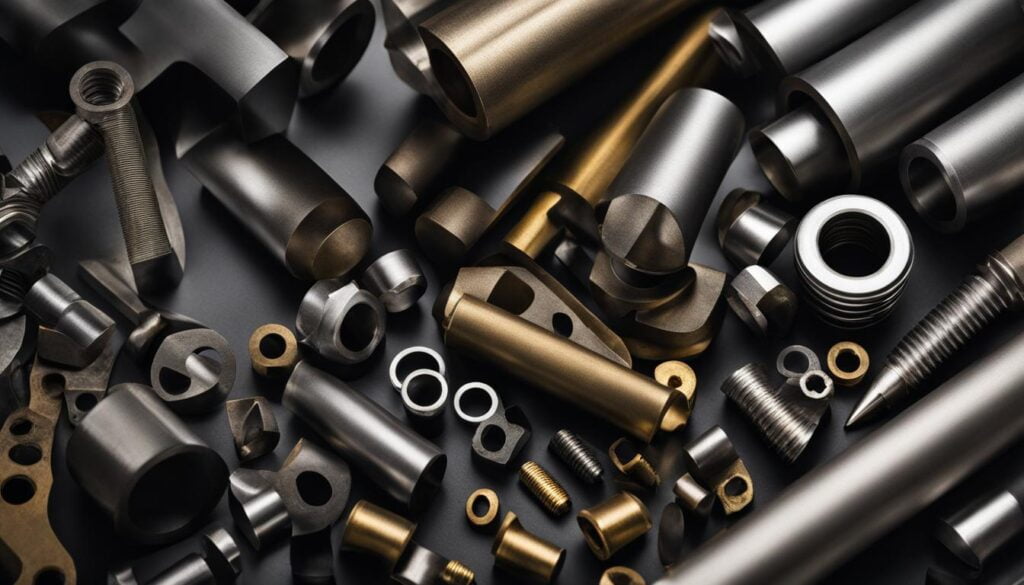Carbon steel alloys are an integral part of a diverse range of industries, thanks to their combination of strength, durability, and recyclability. Comprised primarily of iron, with carbon content representing less than 2% of their makeup, these alloys may also contain additional elements, such as chromium, manganese, and nickel, to further enhance their properties. With over 3,500 variations to choose from, carbon steel can be classified according to its carbon content into low, medium, and high categories, each offering distinct advantages in terms of hardness, ductility, and workability. In this article, we at KT-Foundry will explore the properties of carbon steel alloys and the key industrial steel applications they have to offer, particularly in regard to alloy steel castings.
Key Takeaways
- Carbon steel alloys contain less than 2% carbon, with other alloying elements added to improve specific properties.
- Low, medium, and high categories of carbon content determine hardness, ductility, and workability.
- Chromium, manganese, and nickel enhance strength, corrosion resistance, and other characteristics.
- AISI/SAE and ASTM grading systems help categorize steel alloys based on their composition and properties.
- Carbon steel alloys are widely used in construction, automotive, and manufacturing industries.
- Industrial steel applications include alloy steel castings, structural materials, and automotive components.
- KT-Foundry focuses on selecting the right carbon steel alloy for optimal performance and longevity across industries.
Understanding Carbon Steel and Its Key Characteristics
Carbon steel is an iron-carbon alloy containing less than 2% carbon, which serves as the main hardening element in the alloy. The addition of carbon increases the tensile strength, hardness, and resistance to wear of carbon steel. Conversely, the presence of carbon decreases ductility and machinability. To better comprehend the characteristics of carbon steel, it is vital to review the categorization of carbon steels based on their carbon content and the effects of adding alloying elements.

| Carbon Steel Type | Carbon Content | Key Characteristics |
|---|---|---|
| Low-Carbon Steel | Up to 0.15% | Soft, ductile, lower tensile strength |
| Medium-Carbon Steel | Up to 0.50% | Good balance of ductility and strength, better wear resistance |
| High-Carbon Steel | Up to 1.10% | High strength and hardness, reduced ductility and weldability |
In addition to the carbon content that defines categories of carbon steels, other elements can be added during the production process to further enhance the steel’s properties. Alloy steels comprise carbon steel with the addition of alloying elements. These steels are classified as high-alloy or low-alloy, depending on the percentage of elements introduced during production. Grading systems like AISI/SAE and ASTM help categorize steel alloys by their composition and properties.
“Alloy steels combine carbon steel with alloying elements.”
- Low-Alloy Steel
- High-Alloy Steel
Each category of carbon steel displays varying combinations of tensile strength, ductility, and machinability. Therefore, understanding the classification of carbon steels and the impact of alloying elements is essential for identifying the suitable steel alloy for specific applications and industries.
The Classification of Carbon Steel Alloys
Carbon steel alloys are categorized based on their carbon content, which significantly impacts their properties and potential applications. We will explore the three main categories of carbon steel, covering low-carbon steel, medium-carbon steel, and high-carbon steel.
Low-Carbon Steel Alloys
Low-carbon steel, commonly referred to as mild steel, contains up to 0.15% carbon. This type of steel is known for its outstanding formability and exhibits high ductility and relatively low tensile strength. Due to these properties and its low cost, mild steel is the most popular form of steel employed in numerous applications.
Surface hardness of low-carbon steel can be enhanced through a process known as carburization.
Mild steel is frequently utilized in manufacturing automotive components and construction materials, such as rebar and structural beams.
Medium-Carbon Steel Alloys
Medium-carbon steel possesses a medium carbon content, with its range spanning from 0.3% to 0.5%. This classification of steel strikes an optimal balance between strength and ductility, while still offering good wear resistance. As a result, medium-carbon steel is well-suited for making larger parts, forging, and manufacturing automotive components that call for a higher degree of durability.
High-Carbon Steel Alloys
High-carbon steel contains a carbon content that falls between 0.6% and 1.0%. This steel alloy is recognized for its extreme strength and hardness, making it perfect for applications such as springs, edged tools, and high-strength wires.
Heat treatment can be employed to further improve the properties of high-carbon steel, but a higher carbon content may also reduce ductility and weldability.
In conclusion, the classification of carbon steel alloys, from low to high-carbon, greatly impacts their properties and potential applications. Understanding these differences helps to identify the best type of steel for your specific project, be it automotive components, construction materials, or high-strength wires.
Enhancing Properties with Alloying Elements
Carbon steel alloys can be improved and tailored to suit various applications by introducing alloying elements to enhance their mechanical properties. Common alloying elements such as chromium, nickel, manganese, molybdenum, and silicon contribute to superior strength, wear resistance, hardenability, and corrosion resistance of steel alloys.

Let’s delve deeper into the roles played by these key alloying elements:
- Chromium: This element adds significantly to the corrosion resistance and hardenability of steel. Chromium forms a passive oxide layer on the steel surface to shield it from the surrounding environment, thus preventing corrosion. It also increases hardness, making steel more wear-resistant.
- Nickel: Nickel boosts both strength and toughness of steel alloys. Its addition to carbon steel improves hardenability and lends excellent resistance to corrosion, allowing the material to withstand demanding conditions.
- Manganese: Manganese contributes to the steel alloy’s overall strength, hardness, and toughness. It also helps in removing oxygen and sulfur inclusions during the steel-making process.
- Molybdenum: This alloying element increases high-temperature strength and hardenability. Moreover, it refines the grain structure of steel and improves its resistance to wear and corrosion.
- Silicon: Silicon strengthens steel alloys by increasing the elastic modulus. It also refines the grain structure and contributes to enhanced corrosion resistance.
The strategic combination of alloying elements is key to achieving tailored properties in carbon steel alloys, making them functionally adaptable across numerous industries.
Beyond these common alloying elements, other elements, such as tungsten, vanadium, and niobium, have specialized roles in improving specific characteristics of steel alloys, like high-temperature performance, wear resistance, and grain refinement.
To illustrate the influence of various alloying elements on steel properties, let’s examine the following table:
| Alloy Element | Property Enhancement |
|---|---|
| Chromium | Corrosion resistance, hardenability, wear resistance |
| Nickel | Strength, toughness, corrosion resistance |
| Manganese | Strength, hardness, toughness, sulfur and oxygen removal |
| Molybdenum | High-temperature strength, hardenability, wear and corrosion resistance |
| Silicon | Strength, corrosion resistance, grain refinement |
In conclusion, the addition of alloying elements to carbon steel alloys not only enhances their mechanical properties but also transforms the base material into a more versatile and robust solution to withstand demanding conditions.
Industrial Applications of Carbon Steel Alloys
Thanks to the versatile nature of carbon steel alloys, they are widely used in various sectors such as construction and infrastructure, automotive and transportation, and manufacturing and engineering.
Construction and Infrastructure
In the construction sector, carbon steel alloys offer several advantages. Due to their strength and durability, they are the preferred choice for building and maintaining infrastructure. Carbon steel is typically used in making steel construction materials such as reinforcing bars, steel beams, and various types of fasteners. The table below showcases the various elements of infrastructure and their corresponding steel components.
| Element of Infrastructure | Steel Component |
|---|---|
| Buildings and bridges | Reinforcing bars, steel beams, plates, and coils |
| Highways and railroads | Rail tracks, guardrails, and fasteners |
| Utility infrastructure | Steel pipes and cable supports |
Automotive and Transportation
Carbon steel alloys are also indispensable within the automotive industry and transportation sector. They are frequently used in the manufacture of vehicle components such as gears, pulleys, shafts, and rotors. One common type of low alloy steel is high-tensile steel, which contains additional alloying components that bolster its strength. High-tensile steel is commonly employed in manufacturing vehicle chassis and other critical components.
Manufacturing and Engineering
Thanks to their machinability and versatility, carbon steel alloys are ideal for the production of tools and machinery in the manufacturing and engineering sectors. Some common applications of carbon steel alloys in these industries include:
- Machine tools: lathes, milling machines, cutting tools, and presses
- Steel dies and molds: used in injection molding and metal stamping
- Conveyors: conveyor belts, rollers, and idlers
- Mining equipment: drill bits, hammers, and crushing machines
- Hand tools: wrenches, screwdrivers, hammers, and pliers
In essence, the importance of carbon steel alloys in modern industries cannot be overstated. This versatile material delivers the right balance between strength, durability, and machinability, making it ideal for a wide range of applications across various sectors.
Conclusion
Carbon steel alloys play a vital role in various industries, offering a mix of strength, versatility, and sustainability. Selecting the most suitable carbon steel alloy is crucial for optimal performance and longevity, from simple tools to complex structural components. At KT-Foundry, we understand the importance of choosing the right steel alloy for each specific application and strive to provide the best solutions for our clients.
One of the significant advantages of steel alloys is their ability to be tailored to meet specific requirements, ensuring that components and structures perform optimally under various conditions. This adaptability makes steel alloys a popular choice across multiple sectors such as construction, automotive, and manufacturing.
Additionally, the recyclability of carbon steel further underscores its benefits, contributing to more sustainable industrial practices. By promoting the use of sustainable steel options, we can help reduce the overall environmental impact of manufacturing processes. In conclusion, understanding the properties and applications of carbon steel alloys is essential for making informed decisions and maximizing their potential across different industries.
FAQ
What are the main categories of carbon steel alloys?
Carbon steel alloys are classified based on their carbon content into low, medium, and high categories. Low-carbon steel contains up to 0.15% carbon, medium-carbon steel contains up to 0.50% carbon, and high-carbon steel contains up to 1.10% carbon.
How do alloying elements improve carbon steel properties?
Alloying elements such as chromium, manganese, and molybdenum can enhance strength, hardness, and resistance to wear, while nickel and silicon may improve toughness and corrosion resistance. These elements make carbon steel a more versatile material for various applications and demanding conditions.
What are the industrial applications of carbon steel alloys?
Carbon steel alloys are widely used in construction and infrastructure, automotive and transportation, and manufacturing and engineering industries. They are found in components such as reinforcing bars, beams, vehicle chassis, gears, pulleys, machine tools, and hand tools, among others.
What advantages does KT-Foundry provide in selecting carbon steel alloys?
At KT-Foundry, we recognize the importance of selecting the right steel alloy for the job, ensuring optimal performance and longevity. We use our expertise in alloy properties and applications to guide customers in their choices while also promoting sustainable steel options through recyclability.
What is the role of grading systems like AISI/SAE and ASTM in categorizing steel alloys?
Grading systems such as AISI/SAE and ASTM help categorize steel alloys based on their composition and properties. These grading systems ensure that the specific alloy meets industry standards and performs as intended in various applications.


